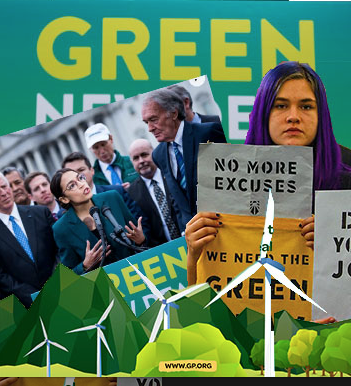A recent United Nations report predicts that worsening food shortages, deadly heat waves and mass die-off of coral reefs will occur in a mere 20 years if greenhouse gas emissions continue at the current rate. In 1896, Swedish scientist Svante Arrhenius came to the conclusion that carbon emissions were, in fact, warming the Earth. That was 123 years ago.
In the 1980s, frequent droughts, heat waves and wildfires catapulted discussion on the climate crisis and began to shape political policies. The world and our country is, and has been, fully aware for decades of the industry’s impact on climate change and the extreme threat it is posing for our longevity on this planet. So, why then are we not implementing fierce changes to our economy and ways of life in order to secure our future?
The Green New Deal calls for the “10-year national mobilization” to change how we live, produce and consume within the limits of our planet. Representative Alexandria Ocasio-Cortez of New York and Senator Edward J. Markey of Massachusetts proposed the legislation in February but it was turned down in the Senate in March. However, the Green New Deal has heightened concerns about the environment nationwide, with most in agreement that we must do something to save our planet before it’s too late.
The Deal, which combines Roosevelt’s economic approach from the “New Deal” of the 30s with more modern ideas, aims to meet “100 percent of the power demand through clean, renewable, and zero-emission energy sources.” It outlines a plan to overhaul our transportation systems, upgrade power grids, and make the shift to cleaner energy like wind and solar. The Deal also addresses the issue of economic inequality and proposes to “create millions of good, high-wage jobs in the United States” as well as provide healthcare for all.
As of now, corporate polluters and billionaires are benefitting in this economy while the working middle class is being subject to dead-end jobs, stagnant wages and exposure to toxic pollution. Climate change and inequality are linked, which is why the Deal addresses both. If a low-income community is hit by a large storm or disaster, the recovery is going to be much harder than it would be in an more affluent community. Inequality aggravates the climate crisis by stripping communities of the resources necessary to cope with extreme climates.
As of now, over 80 percent of America’s energy consumption comes from fossil fuels. The Deal would essentially eradicate these industries and push the nation to rely on more sustainable and renewable forms of energy–but the change would come at a hefty price for Americans and broaden the government’s role in the economy.
Scientists agree that the goals of the Deal are technologically feasible, but are not certain that it could be accomplished within the ten-year time frame. It will cost trillions of dollars and will have to require serious sacrifice by American citizens and the federal government. However, we would potentially be saving trillions if we prevent future catastrophes. It’s important to asses the lengths at which we will go to protect the environment for the sake of ours and other generations to come.
Rep Ocasio-Cortez states, “Our first step is to define the problem and define the scope of the solution. We are here to say that small and incremental policy solutions are not enough.” Many Republicans and Democrats alike in Congress have voiced disapproval of the Deal, claiming its goals are too “ambitious” and “not practical.” Several congress members have expressed concern with the proposal’s vagueness and lack of specificity. President Trump, who has called climate change a “hoax” has repeatedly mocked the Green New Deal, calling it a “high school term paper that got a low mark.” However, supporters and sponsors claim that the Deal is simply a call to arms rather than a strict policy proposal. Co-sponsors of the deal include many of the potential 2020 candidates: Sen Bernie Sanders, Cory Booker, Kamala Harris, Amy Klobuchar, Elizabeth Warren and Kirsten Gillibrand. The Deal addresses a lot, so not all parts are popular. Ideas like a full shift to electric cars by 2030 and eradicating all power plants by 2035 are not entirely well-favored. However, a poll shows that policies like green jobs, reforestation and better drinking water infrastructure has unanimous citizen-approval in most states.
The Green New Deal is not only helping to fuel the discussion of climate change but is illustrating how significant change and reform is getting caught up in the tactics of politics. Republican strategist Ron Bonjean stated that the proposal “will be a piñata that Republicans will continue to hit and use to their advantage in the 2020 election.” The bottom line is a piece of legislation that could potentially implement changes necessary to save the planet will be fought over for a long time. And during that time, climate change will continue
Julia Zambito
staff writer
Graphic: Sofia Lee

